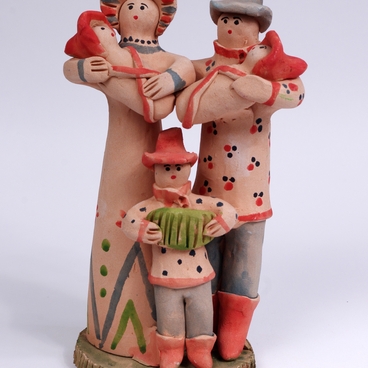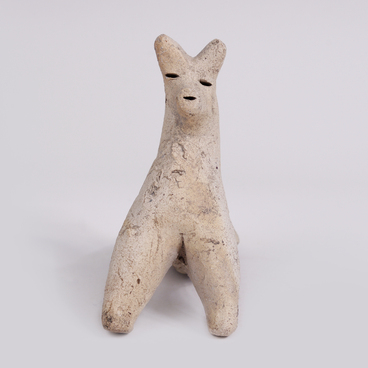The toy-whistle ‘Ram’ was made by the Russian craftsman Vladimir Lobyntsev. The artist sculpted the ram’s horns twisted into a circle, which clearly protrudes forward. The artisan carefully modeled the toy’s shape and measured its dimensions with utmost precision, up to a millimeter, to make the figurine rest firmly on four legs.
The artist pricked the dots that render the toy’s eyes and nose with a sharp matchstick. There are also punctures in the back of the torso — to make the whistle sound. The craftsman made them with a special sharp little stick. The sculptor used red clay in order to get a pleasant warm orange tone after firing. To make the toy sufficiently chip resistant, it is usually fired in a kiln for 4.5 hours at a temperature of up to 1000 degrees.
The ram is one of the oldest images in the pagan cults of Old Rus’. Archaeologists often found this symbol in Slavic burials of the 6th — 8th centuries and during the excavations of Russian cities of the 10th — 14th centuries. In Oskol, clay rams appeared in the 16th century, almost at the same time as horses and birds — although in mythology the ram is not as close to the Sun as the bird or the horse. The way these toys look has hardly changed over time. Ram figurines have also always served as whistles.
In general, the craft of making clay toys most likely appeared in Stary Oskol at the same time as pottery did. In the process of pottery making, the artisans put small toys among large vessels to occupy the space in the large kiln. These toys were made mainly from the remains of the clay, so they were cheap and quite common. The Oskol potters were mentioned for the first time in the manuscript records of 1615 — seven artisans were listed there. By the late 19th, there were already 172 artisans, 40 of them lived in the Cossack settlement.
Vladimir Lobyntsev devoted his whole life to keeping the Stary Oskol old craft traditions. Each of his toys harmoniously combines the author’s style with the caring attitude to the traditional modeling and painting techniques. Lobyntsev learned the craft from the hereditary Stary Oskol craftswomen Olga and Natalia Goncharova. The craftswomen used to sculpt ram figurines as well — “little rams”, as they called them.
The artist pricked the dots that render the toy’s eyes and nose with a sharp matchstick. There are also punctures in the back of the torso — to make the whistle sound. The craftsman made them with a special sharp little stick. The sculptor used red clay in order to get a pleasant warm orange tone after firing. To make the toy sufficiently chip resistant, it is usually fired in a kiln for 4.5 hours at a temperature of up to 1000 degrees.
The ram is one of the oldest images in the pagan cults of Old Rus’. Archaeologists often found this symbol in Slavic burials of the 6th — 8th centuries and during the excavations of Russian cities of the 10th — 14th centuries. In Oskol, clay rams appeared in the 16th century, almost at the same time as horses and birds — although in mythology the ram is not as close to the Sun as the bird or the horse. The way these toys look has hardly changed over time. Ram figurines have also always served as whistles.
In general, the craft of making clay toys most likely appeared in Stary Oskol at the same time as pottery did. In the process of pottery making, the artisans put small toys among large vessels to occupy the space in the large kiln. These toys were made mainly from the remains of the clay, so they were cheap and quite common. The Oskol potters were mentioned for the first time in the manuscript records of 1615 — seven artisans were listed there. By the late 19th, there were already 172 artisans, 40 of them lived in the Cossack settlement.
Vladimir Lobyntsev devoted his whole life to keeping the Stary Oskol old craft traditions. Each of his toys harmoniously combines the author’s style with the caring attitude to the traditional modeling and painting techniques. Lobyntsev learned the craft from the hereditary Stary Oskol craftswomen Olga and Natalia Goncharova. The craftswomen used to sculpt ram figurines as well — “little rams”, as they called them.

